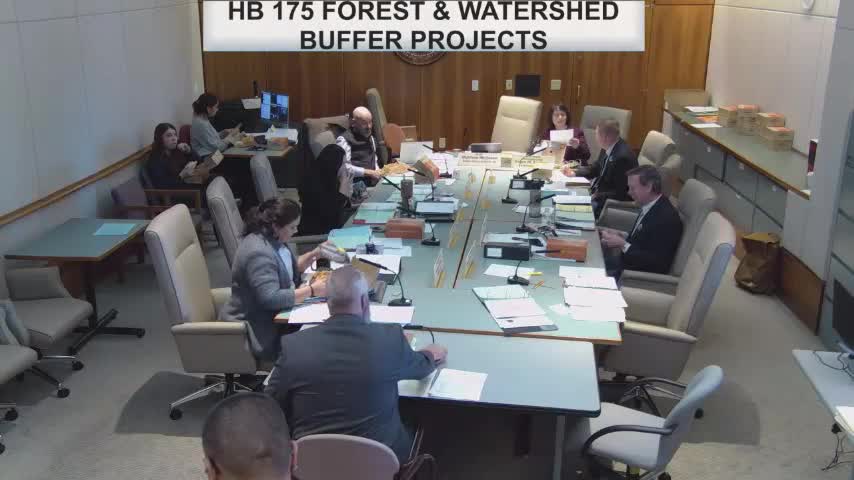New Mexico Legislators Advance Forest and Watershed Restoration Act for Wildfire Prevention
February 08, 2025 | Energy, Environment & Natural Resources, House of Representatives, Committees, Legislative, New Mexico
This article was created by AI summarizing key points discussed. AI makes mistakes, so for full details and context, please refer to the video of the full meeting. Please report any errors so we can fix them. Report an error »

In a pivotal meeting held on February 8, 2025, the New Mexico Legislature's House Committee on Energy, Environment, and Natural Resources discussed the urgent need for wildfire prevention measures through the proposed Forest and Watershed Restoration Act Amendment, known as HB 175. As the committee convened, the atmosphere was charged with a sense of responsibility, reflecting on the devastating impacts of recent wildfires, particularly the South Fork fire that ravaged the village of Ruidoso in June 2024.
The bill aims to establish strategic buffer zones between natural vegetation and residential areas, a proactive measure designed to slow the spread of wildfires. By creating these barriers, emergency responders would gain critical time to protect communities, enhancing their operational safety and effectiveness. The proposed legislation emphasizes a scientifically informed approach to wildfire risk management, addressing the vulnerabilities of communities situated near unmanaged landscapes.
Key proponents of the bill highlighted the necessity of these buffer zones, citing the tragic loss of life and property during past wildfires. The bill not only seeks to define high-risk areas but also aims to expand the Forest Conservation Act, ensuring that funding is available for the creation and maintenance of these protective measures. With a fiscal overview indicating that the initiative would leverage existing resources without imposing additional financial burdens on the state, the committee expressed optimism about the bill's potential impact.
Supporters from various sectors, including local government representatives and environmental advocates, voiced their backing for HB 175. They underscored the importance of proactive forest management in safeguarding lives and property while also preserving the natural environment. The Mescalero Apache Tribe, recognized for its leadership in forest management, emphasized the dual benefits of reducing wildfire risks and promoting biodiversity.
As discussions unfolded, committee members acknowledged the bipartisan nature of the bill, with a shared commitment to preventing future tragedies. The unanimous vote in favor of the bill signaled a collective determination to enhance community safety and resilience against the growing threat of wildfires.
In conclusion, the passage of HB 175 represents a significant step forward in New Mexico's efforts to combat wildfire risks. By transforming reactive emergency responses into proactive community protection, the state aims to safeguard its residents and natural resources, fostering a safer environment for all. As the legislative process continues, the commitment to collaborative action remains strong, with hopes for a future where communities are better equipped to face the challenges posed by wildfires.
The bill aims to establish strategic buffer zones between natural vegetation and residential areas, a proactive measure designed to slow the spread of wildfires. By creating these barriers, emergency responders would gain critical time to protect communities, enhancing their operational safety and effectiveness. The proposed legislation emphasizes a scientifically informed approach to wildfire risk management, addressing the vulnerabilities of communities situated near unmanaged landscapes.
Key proponents of the bill highlighted the necessity of these buffer zones, citing the tragic loss of life and property during past wildfires. The bill not only seeks to define high-risk areas but also aims to expand the Forest Conservation Act, ensuring that funding is available for the creation and maintenance of these protective measures. With a fiscal overview indicating that the initiative would leverage existing resources without imposing additional financial burdens on the state, the committee expressed optimism about the bill's potential impact.
Supporters from various sectors, including local government representatives and environmental advocates, voiced their backing for HB 175. They underscored the importance of proactive forest management in safeguarding lives and property while also preserving the natural environment. The Mescalero Apache Tribe, recognized for its leadership in forest management, emphasized the dual benefits of reducing wildfire risks and promoting biodiversity.
As discussions unfolded, committee members acknowledged the bipartisan nature of the bill, with a shared commitment to preventing future tragedies. The unanimous vote in favor of the bill signaled a collective determination to enhance community safety and resilience against the growing threat of wildfires.
In conclusion, the passage of HB 175 represents a significant step forward in New Mexico's efforts to combat wildfire risks. By transforming reactive emergency responses into proactive community protection, the state aims to safeguard its residents and natural resources, fostering a safer environment for all. As the legislative process continues, the commitment to collaborative action remains strong, with hopes for a future where communities are better equipped to face the challenges posed by wildfires.
View full meeting
This article is based on a recent meeting—watch the full video and explore the complete transcript for deeper insights into the discussion.
View full meeting
